Restoration of the film
by Cristiana Miranda
The restoration process of the film Copacabana Mon Amour involved studying all the existing material related to the film, in different substrate and media. The collection of Rogério Sganzerla was located at Cinemateca Brasileira when the work of restoring the film began. Initially, Cinemateca Brasileira sent us reels containing the original sound and image negatives, processed by Laboratório Líder in 1970 and magnetic material related to the sound.*
Identification of the materials received:
• Original edited image negative, on a 1'2:35 scope screen, with acetate substrate, color and black and white emulsion.
• Original sound negative with double track variable area optical tape recorded photographically onto film with acetate substrate and AGFA Black and White emulsion.
Color emulsion: EASTMAN •|+1
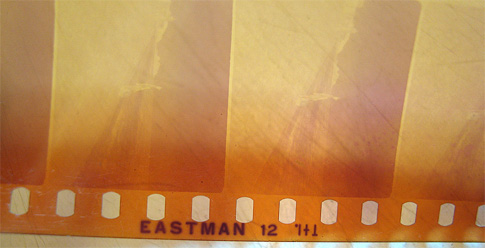
Black and White emulsion: FERRANIA

State of conservation of original image negative:
The image negative of the film Copacabana Mon Amour is formed by two types of emulsion. One part has color emulsion and another has black and white emulsion. The two emulsions have acetate substrate.
The color part of the film has vinegar syndrome at the first stage of deterioration of the acetate substrate. The film has no visible alteration, but exhales a mild odor of vinegar.
The black and white part of the film has vinegar syndrome in the second stage of deterioration. The odor of vinegar is more intense; the substrate is softer and has no rigidity, accompanied by buckling. A type of fine pattern of dense cracking can be seen in the shine of the substrate when exposed to light.
The color and black and white negatives have superficial, intermittent and fine scratch marks on the substrate. The scratch marks are located at the start and end of the reels. The negative has superficial scratching on the emulsion.
The negative has large amounts of fungus on the image, causing visible interference to the image. The fungus is mainly located on the color negative, at the start and end of the reels.
The image in the color negative exhibits some discoloring, with loss of the primary blue color. We can see the discoloring of the original negative by looking at the dress of the film's main character, which is bright red in the positive copy and green in the original negative, when it should in fact be light green. If the coloration of the dress in the negative is green, the result obtained in the positive copy, using the original negative, would be pink, a difference in relation to the original red of the image that cannot be corrected satisfactorily with the use of any filtering resource.
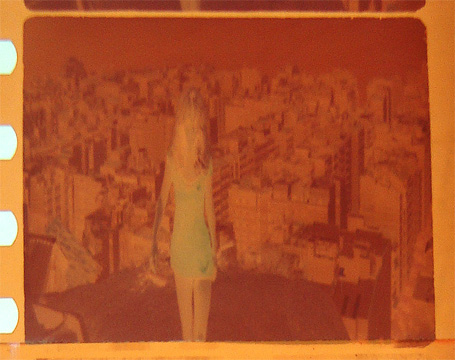
For the color negative, a technical 3C grade was attributed. For the black and white negative, a technical grade 3Cx was attributed.
The remaining parts, denominated "definitive", of the color and B&W negatives have vinegar syndrome in a more advanced stage of decomposition. The negatives with Black and White emulsion of the "definitive" remaining parts are delaminated in the fourth stage and the film is highly deteriorated, with loss of emulsion, an intense odor of vinegar and warping of the substrate.
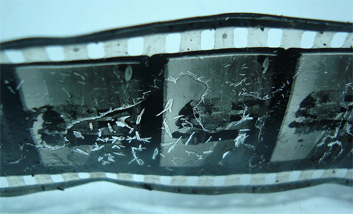

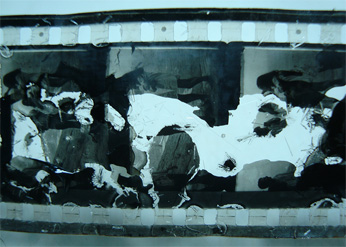
State of conservation of the original sound negative:
The original sound negative has vinegar syndrome in the second stage of deterioration. The odor of vinegar is intense; the substrate is softer and lacks rigidity, accompanied by buckling. The substrate has several broken and torn sprocket holes and some tears. A Technical Grade 3Cx was attributed to the original sound negative.
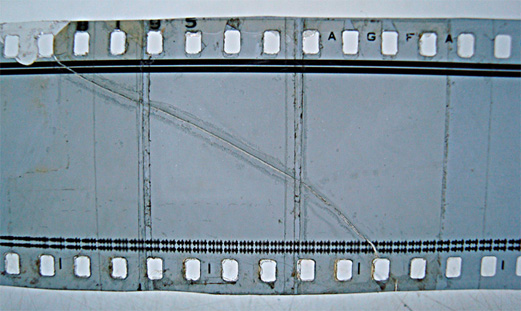
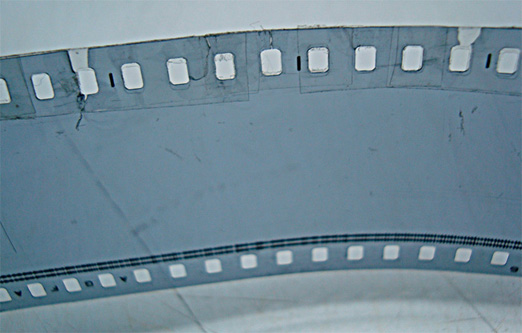
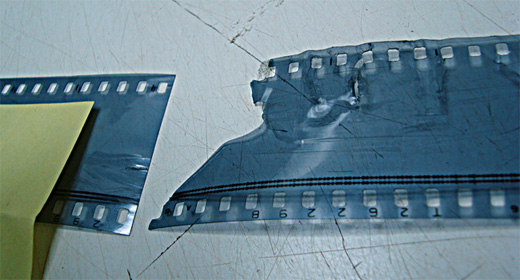
Integrity of the material received - Image negative:
We received 7 cans containing the 8 reels of the edited image negative and 4 cans containing what in principle were considered remaining parts not used in the edited image negative. But we then realized that these remaining parts were actually edited, with some numbered and other unnumbered edits. This indicated that the film had possibly been altered in relation to the previous version, or versions - which ended up proving to be the case.
The quantity of reels of the material related to the original negative image is 8 and the quantity of cans containing these reels is 7. Reels 7 and 8 are together in a single reel and stored in the same can. The total length of the 8 reels stored in the 7 cans of original image negative is 2,173 meters.
The material received at this time showed that the original editing had been modified, and the sequence of the numbering of the edits is incomplete, the initial credits were added in 2005, at which point the film received its last modification due to the making of a copy with English subtitles by Cinemateca Brasileira - at which time the numbering of the original ends of the original reels was altered.
Integrity of the material received - Sound negative:
The sound negative received from Cinemateca Brasileira corresponds to the original 1970 version and is complete.
Second batch of film materials received:
In a subsequent stage of the restoration work of the film Copacabana Mon Amour, Cinemateca Brasileira sent us a combined positive copy with English subtitles, dated 2005, and an incomplete combined positive copy from the 1980s with no subtitles.
State of conservation of copy without subtitles:
The copy without subtitles is incomplete and has vinegar syndrome in the first stage, with strong fading of the color image. A Technical Grade 3C was attributed to the copy without subtitles.
The copy has superficial, intermittent and fine scratch marks on the substrate and emulsion. The scratch marks are located throughout the reels.
State of conservation of copy with English subtitles:
The copy with English subtitles, dated 2005, is the film material of the movie in the best condition. The acetate substrate has no visible signs of vinegar syndrome and does not exhale any odor of vinegar. A Technical Grade 1B was attributed to the copy with English subtitles.
The copy has superficial, intermittent and fine scratch marks on the substrate and the emulsion. The marks are located at the start and end of the reels. The image has mild fading of the original colors, with no loss of any primary color.
The copy with English subtitles has non-original credits redone by Cinemateca Brasileira and is reedited, in comparison to the original edited negative received in the first batch sent by Cinemateca Brasileira.
The studies and research revealed the existence of other versions of the film Copacabana Mon Amour as compared to the original negative received. We discovered versions in VHS and DVD formats. The presence of the different existing versions of the film in the different media formats raised two questions in relation to the restoration work: (i) what was the original version created by the author of the film in 1970; and (ii) which material received would enable optimal reconstitution of the film, both from the standpoint of its original integrity and state of conservation.
There was enormous difficulty defining the original version of the film Copacabana Mon Amour and we discovered that only one material had the sufficient technical quality to recover the remaining image and sound of the film. This material is the copy with English subtitles, dated 2005, and which is here called the Turin version. The decision to use the later Turin version was based on the state of conservation of the original image negative, which due to the deterioration of the image and substrate prevented it from being copied with satisfactory quality. The original negative has vinegar syndrome in the substrate, extensive fungus on the image and discoloration of the original color, with loss of a primary color: blue.
To produce the inter-negative image of 35mm scope, 2:35, color, necessary for the restoration work, the Turin version was used, and also telefilmed in Full HD format, with light marking in the online telefilm of the LaboCine cinematographic laboratory.
Some frames from the film prior to the restoration work (click on image to enlarge):



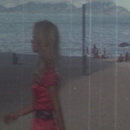
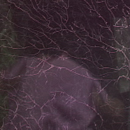
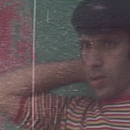
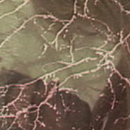

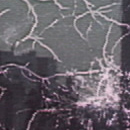

______________________
* Materials received at Cinemateca do MAM on 25 February 2011, sent by Cinemateca Brasileira:
• 1 CD containing the sound of the magnetic reel.
• Sound negatives: total of 9 cans
1. number: 08178-01: can reel 1/8
2. number: 08178-01: can reel 2/8
3. number: 01015Y: can reel 1 and 2/8 dual track
4. number: 01015Y: can reel 3 and 7/8 dual track
5. number: 01015Y: can 4 and 8/8 dual track
6. number: 01015Y: can reel 3(P4)(9)/6
7. number: 08178-01: can reel 7 and 8/8
8. number: 01015Y: can reel 6/8
9. number 01015Y: can reel 5/8
• Image negatives: total of 8 cans
1. number: 07573-06X: can reel 1/1
2. number: 01015X: can reel 7 and 8/8
3. number: 01015X: can reel 6/7
4. number: 01015X: can reel 5/7
5. number: 01015X: can reel 4/7
6. number: 01015X: can reel 3/7
7. number: 01015X: can reel 2/7
8. number: 01015X: can reel 1/7
• Remaining image negatives: total of 3 cans
1. number: 36784-01: can reel 1-15/15
2. number: 07450-04: can reel 2/3
3. number: 07450-04: can reel 1 and 3/3
• Magnetic sound material: total of 1 can
1. number: 08178-02: can reel 1 and 4/4
 |